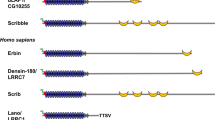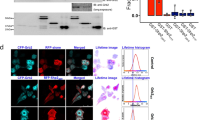Abstract
Grb7 family adaptor molecules consist of Grb7, Grb10 and Grb14, each of which has several splicing variants. Like other adaptor molecules, Grb7 family proteins function to mediate the coupling of multiple cell surface receptors to downstream signaling pathways in the regulation of various cellular functions. They share significant sequence homology with each other and a conserved molecular architecture including an amino-terminal proline-rich region, a central segment termed the GM region (for Grb and Mig) which includes a PH domain and shares sequence homology with the Caenorhabditis elegans protein, Mig-10, involved in embryonic migration, and a carboxyl-terminal SH2 domain. Grb7 family proteins are differentially expressed in a variety of tissues. They are phosphorylated on serine/threonine as well as tyrosine residues, although the kinases responsible have not been well characterized. Grb7 family proteins are mainly localized in the cytoplasm, but have been observed at the plasma membrane, focal contacts, or mitochondria under certain conditions. A large number of receptor tyrosine kinases and other signaling molecules can associate with Grb7 family proteins, mostly through the SH2 domains. Various isoforms of Grb10 have been shown to regulate cell proliferation and apoptosis, whereas Grb7 has been found to regulate cell migration and also implicated in tumor progression. Future studies of interests will include identification of potential downstream effectors of Grb7 family proteins as well as understanding of the mechanisms of specificity of the different family members in signal transduction.
This is a preview of subscription content, access via your institution
Access options
Subscribe to this journal
Receive 50 print issues and online access
$259.00 per year
only $5.18 per issue
Buy this article
- Purchase on Springer Link
- Instant access to full article PDF
Prices may be subject to local taxes which are calculated during checkout

Similar content being viewed by others
References
Bai RY, Jahn T, Schrem S, Munzert G, Weidner KM, Wang JY, Duyster J . 1998 Oncogene 17: 941–948
Daly RJ . 1998 Cell Signal 10: 613–618
Daly RJ, Sanderson GM, Janes PW, Sutherland RL . 1996 J. Biol. Chem. 271: 12502–12510
Dey BR, Frick K, Lopaczynski W, Nissley SP, Furlanetto RW . 1996 Mol. Endocrinol. 10: 631–641
Dong LQ, Du H, Porter SG, Kolakowski Jr LF, Lee AV, Mandarino LJ, Fan J, Yee D, Liu F, Mandarino J . 1997 J. Biol. Chem. 272: 29104–29112
Dong LQ, Porter S, Hu D, Liu F . 1998 J. Biol. Chem. 273: 17720–17725
Fiddes RJ, Campbell DH, Janes PW, Sivertsen SP, Sasaki H, Wallasch C, Daly RJ . 1998 J. Biol. Chem. 273: 7717–7724
Frantz JD, Giorgetti-Peraldi S, Ottinger EA, Shoelson SE . 1997 J. Biol. Chem. 272: 2659–2667
Guan JL . 1997 Matrix Biol. 16: 195–200
Han DC, Guan JL . 1999 J. Biol. Chem. 274: 24425–24430
Han DC, Shen TL, Guan JL . 2000 J. Biol. Chem. 275: 28911–28917
Hansen H, Svensson U, Zhu J, Laviola L, Giorgino F, Wolf G, Smith RJ, Riedel H . 1996 J. Biol. Chem. 271: 8882–8886
He W, Rose DW, Olefsky JM, Gustafson TA . 1998 J. Biol. Chem. 273: 6860–6867
Janes PW, Lackmann M, Church WB, Sanderson GM, Sutherland RL, Daly RJ . 1997 J. Biol. Chem. 272: 8490–8497
Jones N, Master Z, Jones J, Bouchard D, Gunji Y, Sasaki H, Daly R, Alitalo K, Dumont DJ . 1999 J. Biol. Chem. 274: 30896–30905
Kasus-Jacobi A, Bereziat V, Perdereau D, Girard J, Burnol AF . 2000 Oncogene 19: 2052–2059
Kasus-Jacobi A, Perdereau D, Auzan C, Clauser E, Van Obberghen E, Mauvais-Jarvis F, Girard J, Burnol AF . 1998 J. Biol. Chem. 273: 26026–26035
Keegan K, Cooper JA . 1996 Oncogene 12: 1537–1544
Langlais P, Dong LQ, Hu D, Liu F . 2000 Oncogene 19: 2895–2903
Leavey SF, Arend LJ, Dare H, Dressler GR, Briggs JP, Margolis BL . 1998 Am. J. Physiol. 275: F770–F776
Lee H, Volonte D, Galbiati F, Iyengar P, Lublin DM, Bregman DB, Wilson MT, Campos-Gonzalez R, Bouzahzah B, Pestell RG, Scherer PE, Lisanti MP . 2000 Mol. Endocrinol. 14: 1750–1775
Liu F, Roth RA . 1995 Proc. Natl. Acad. Sci. USA 92: 10287–10291
Lyons RJ, Deane R, Lynch DK, Ye ZS, Sanderson GM, Eyre HJ, Sutherland GR, Daly RJ . 2001 J. Biol. Chem. 276: 17172–17180
Mano H, Ohya K, Miyazato A, Yamashita Y, Ogawa W, Inazawa J, Ikeda U, Shimada K, Hatake K, Kasuga M, Ozawa K, Kajigaya S . 1998 Genes. Cells 3: 431–441
Manser J, Roonprapunt C, Margolis B . 1997 Dev. Biol. 184: 150–164
Manser J, Wood WB . 1990 Dev. Genet. 11: 49–64
Margolis B, Silvennoinen O, Comoglio F, Roonprapunt C, Skolnik E, Ullrich A, Schlessinger J . 1992 Proc. Natl. Acad. Sci. USA 89: 8894–8898
Morrione A, Plant P, Valentinis B, Staub O, Kumar S, Rotin D, Baserga R . 1999 J. Biol. Chem. 274: 24094–24099
Morrione A, Valentinis B, Li S, Ooi JY, Margolis B, Baserga R . 1996 Cancer Res. 56: 3165–3167
Morrione A, Valentinis B, Resnicoff M, Xu S, Baserga R . 1997 J. Biol. Chem. 272: 26382–26387
Moutoussamy S, Renaudie F, Lago F, Kelly PA, Finidori J . 1998 J. Biol. Chem. 273: 15906–15912
Nantel A, Huber M, Thomas DY . 1999 J. Biol. Chem. 274: 35719–35724
Nantel A, Mohammad-Ali K, Sherk J, Posner BI, Thomas DY . 1998 J. Biol. Chem. 273: 10475–10484
O'Neill TJ, Rose DW, Pillay TS, Hotta K, Olefsky JM, Gustafson TA . 1996 J. Biol. Chem. 271: 22506–22513
Ooi J, Yajnik V, Immanuel D, Gordon M, Moskow JJ, Buchberg AM, Margolis B . 1995 Oncogene 10: 1621–1630
Pandey A, Duan H, Di Fiore PP, Dixit VM . 1995 J. Biol. Chem. 270: 21461–21463
Pandey A, Liu X, Dixon JE, Di Fiore PP, Dixit VM . 1996 J. Biol. Chem. 271: 10607–10610
Reilly JF, Mickey G, Maher PA . 2000 J. Biol. Chem. 275: 7771–7778
Reiske HR, Zhao J, Han DC, Cooper LA, Guan JL . 2000 FEBS Lett. 486: 275–280
Slamon DJ, Godolphin W, Jones LA, Holt JA, Wong SG, Keith DE, Levin WJ, Stuart SG, Udove J, Ullrich A, Press MF . 1989 Science 244: 707–712
Stein D, Wu J, Fuqua S, Roonprapunt C, Yajnik V, D'Eustachio P, Moskow J, Buchberg A, Osborne C, Margolis B . 1994 EMBO J. 13: 1331–1340
Stein E, Cerretti DP, Daniel TO . 1996 J. Biol. Chem. 271: 23588–23593
Stein EG, Gustafson TA, Hubbard SR . 2001 FEBS Lett 493: 106–111
Tanaka S, Mori M, Akiyoshi T, Tanaka Y, Mafune K, Wands JR, Sugimachi K . 1997 Cancer Res. 57: 28–31
Tanaka S, Mori M, Akiyoshi T, Tanaka Y, Mafune K, Wands JR, Sugimachi K . 1998 J. Clin. Invest. 102: 821–827
Tanaka S, Sugimachi K, Kawaguchi H, Saeki H, Ohno S, Wands JR . 2000 J. Cell. Physiol. 183: 411–415
Thommes K, Lennartsson J, Carlberg M, Ronnstrand L . 1999 Biochem. J. 341: 211–216
Vayssiere B, Zalcman G, Mahe Y, Mirey G, Ligensa T, Weidner KM, Chardin P, Camonis J . 2000 FEBS Lett. 467: 91–96
Wang HG, Rapp UR, Reed JC . 1996 Cell. 87: 629–638
Wang J, Dai H, Yousaf N, Moussaif M, Deng Y, Boufelliga A, Swamy OR, Leone ME, Riedel H . 1999 Mol. Cell. Biol. 19: 6217–6228
Wojcik J, Girault JA, Labesse G, Chomilier J, Mornon JP, Callebaut I . 1999 Biochem. Biophys. Res. Commun. 259: 113–120
Yokote K, Margolis B, Heldin CH, Claesson-Welsh L . 1996 J. Biol. Chem. 271: 30942–30949
Acknowledgements
Research in the authors' laboratory was supported by NIH grants GM48050 to J-L Guan. J-L Guan is an Established Investigator of the American Heart Association. We are grateful to our colleagues Luis G Rodriguez and Lee Ann Cooper for critical reading of this review and helpful suggestions.
Author information
Authors and Affiliations
Corresponding author
Rights and permissions
About this article
Cite this article
Han, D., Shen, TL. & Guan, JL. The Grb7 family proteins: structure, interactions with other signaling molecules and potential cellular functions. Oncogene 20, 6315–6321 (2001). https://doi.org/10.1038/sj.onc.1204775
Published:
Issue Date:
DOI: https://doi.org/10.1038/sj.onc.1204775
Keywords
This article is cited by
-
GRB10 is a novel oncogene associated with cell proliferation and prognosis in glioma
Cancer Cell International (2022)
-
Unexpected involvement of staple leads to redesign of selective bicyclic peptide inhibitor of Grb7
Scientific Reports (2016)
-
In vitro antiproliferative effect of trastuzumab (Herceptin®) combined with cetuximab (Erbitux®) in a model of human non-small cell lung cancer expressing EGFR and HER2
Clinical and Experimental Medicine (2016)
-
High expression of growth factor receptor-bound protein 14 predicts poor prognosis for colorectal cancer patients
Biotechnology Letters (2016)
-
Context-dependent role of Grb7 in HER2+ve and triple-negative breast cancer cell lines
Breast Cancer Research and Treatment (2014)



